With the Stitch Play series and the refurbishing of the embroidery how-to videos here on Needle ‘n Thread, I’ve received a lot of questions lately about the samples that I show in the series and on the videos. The predominant questions are: What do you do with them? and How can I make a sampler like the ones you show, using the stitches in the videos?
Today, I’ll attempt to answer those questions!
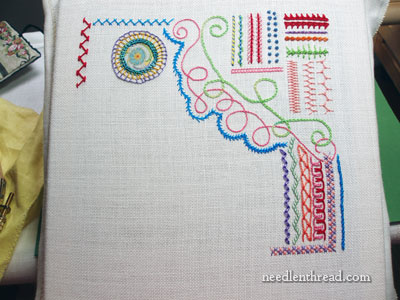
How to Make a Stitch Sampler
There’s no one way to go about making a sampler of stitches. A sampler of stitches really is just that: it’s a collection or sampling of various stitches. How you go about making it is up to you. You can take a linear approach, working out lines of stitches on a band sampler (a long and narrow sampler), you can draw up a design and use random stitches to stitch it, you can start with a blank piece of fabric and just stitch the stitches where you want to, however you want to, in whatever colors or threads you want to.
If your purpose is simply to learn the stitches, work out the techniques, have some fun getting familiar with different stitches and threads – in other words, your purpose is simply to learn – then you can approach a sampler of hand embroidery stitches and techniques Very Randomly.
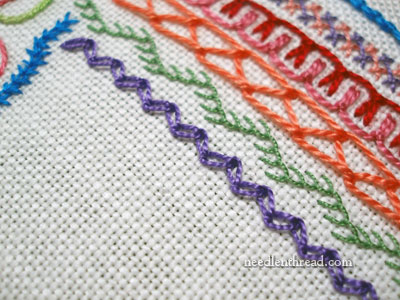
If your purpose is to work up a display piece, then of course, much more planning has to go into the sampler before you even start stitching. But if you just want to learn and to have some fun with various embroidery stitches or threads, then you can pretty much just launch right in with a blank piece of fabric and whatever threads you have on hand.
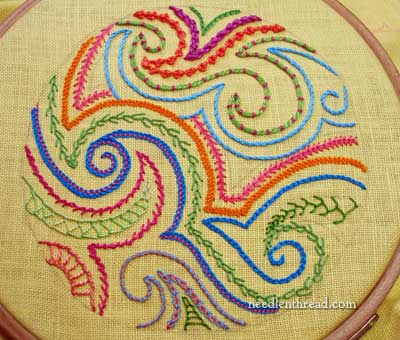
For the samples that I work up for the embroidery how-to videos or for the Stitch Play series, I generally just start on a piece of fabric and work randomly. I might draw a circle or some wavy lines (the yellow piece above is a circle with some randomly drawn wavy lines in it), or I might just stitch in straight lines, or I might do a combination of straight lines, wavy lines, circles, and whatnot. I might work a Stitch Play element and photograph it along the way, and then from there, build up more stitches around it. I don’t generally “plan” stitch samples.
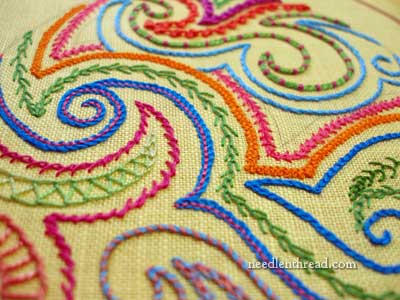
I don’t plan the threads or the colors that I use for these types of samples. Well, let’s say I don’t plan ahead on them. When I decide I want to work a certain stitch or technique out to demonstrate it on the website, I look for a thread that I think will work well with that stitch. It takes a little practice to know what threads will work well with particular stitches, but that’s what a sampler is for – learning.
Materials for Stitch Samplers
My thread fiber of choice for stitch samples like these is generally cotton, although sometimes, I might use a smattering of wool. I use various weights of cotton, from stranded floss to perle cottons, to floche and coton a broder. Why cotton? Because it’s less expensive, it’s easy to come by, and it comes in various weights, with a good range of color.
I use DMC and Anchor cottons, because I am confident in the quality of their threads. There is Nothing Worse than stitching with an inferior quality thread, especially when you are “just playing.” Few things can turn a person off embroidery faster than poor quality materials that are frustrating to work with!
For a ground fabric for this type of stitching, I always choose linen. Why linen? Because it is resilient. Linen withstands the Pressure of Picking better than any fabric, and it holds up to all kinds of stitching. And the better the quality of the linen, the better it holds up.
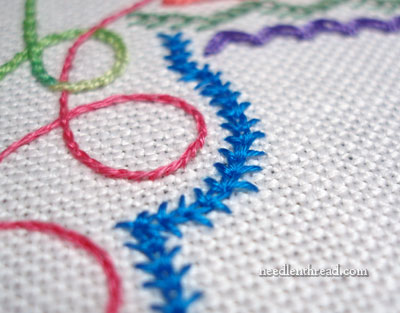
The linen I find most pleasurable to work on (pictured in the photo above) for this type of random “sample stitching” is Round Yarn linen by Legacy. It’s about a 25 count linen, so it can be used for practicing counted stitches, too, but it also works wonderfully for surface stitching (as long as it isn’t extremely fine and delicate surface stitching). The individual threads that make up the linen are so round and plump that they fill the whole weave, making it a nice surface for most stitches. You can also use it for drawn thread work and various types of pulled thread embroidery, so it really does make an all-around good fabric for sampling all kinds of techniques. (You can find it at Hedgehog Handworks. A fat quarter – it’s 71″ wide – runs about $20.00)
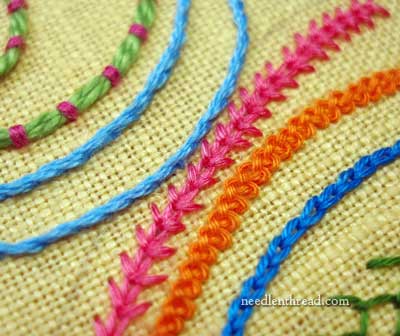
What do You Do with the Stitch Samples?
So I’ve been asked quite a bit what I do with the stitch samples that show up on the website or in the videos. I’m not sure it really matters what happens to stitch samples like these, to a degree. I suppose the point of curiosity is whether or not the samples get used.
My stitch samples go in plastic sleeves in a binder (whenever I get around to putting them in there). No one ever really sees them, but me (and you!). But actually in person, no one ever sees them. Their purpose was to demonstrate something, or to create a picture for the website, or to work out a technique. I did not create them to display in my home, to show to other people (except you!), to make anything out of them, or anything like that. They go in a folder for reference. That’s all I do with them.
Is it a waste, to make all these samples on all this fabric with all these threads, and just file them away? I don’t think so. It serves my purpose and I have a lot of fun doing it. I also learn a lot from the samples – and that’s knowledge I can pass on to others. It’s a great way to build a repertoire of stitches and to become adept at needlework.
I don’t think it’s a waste to use fabric and thread this way. What do you think? Have you ever worked on hand embroidery just to learn the technique or the stitch, or worked up stitch samples just to learn the stitch, and never done anything with the resulting piece of embroidery? I’d love to hear your take on this subject! Do you think I’m a wastrel? Feel free to leave a comment below!
Enjoy your day, wherever you are! And Happy 4th, to those celebrating – I hope it’s a safe and fun day!
